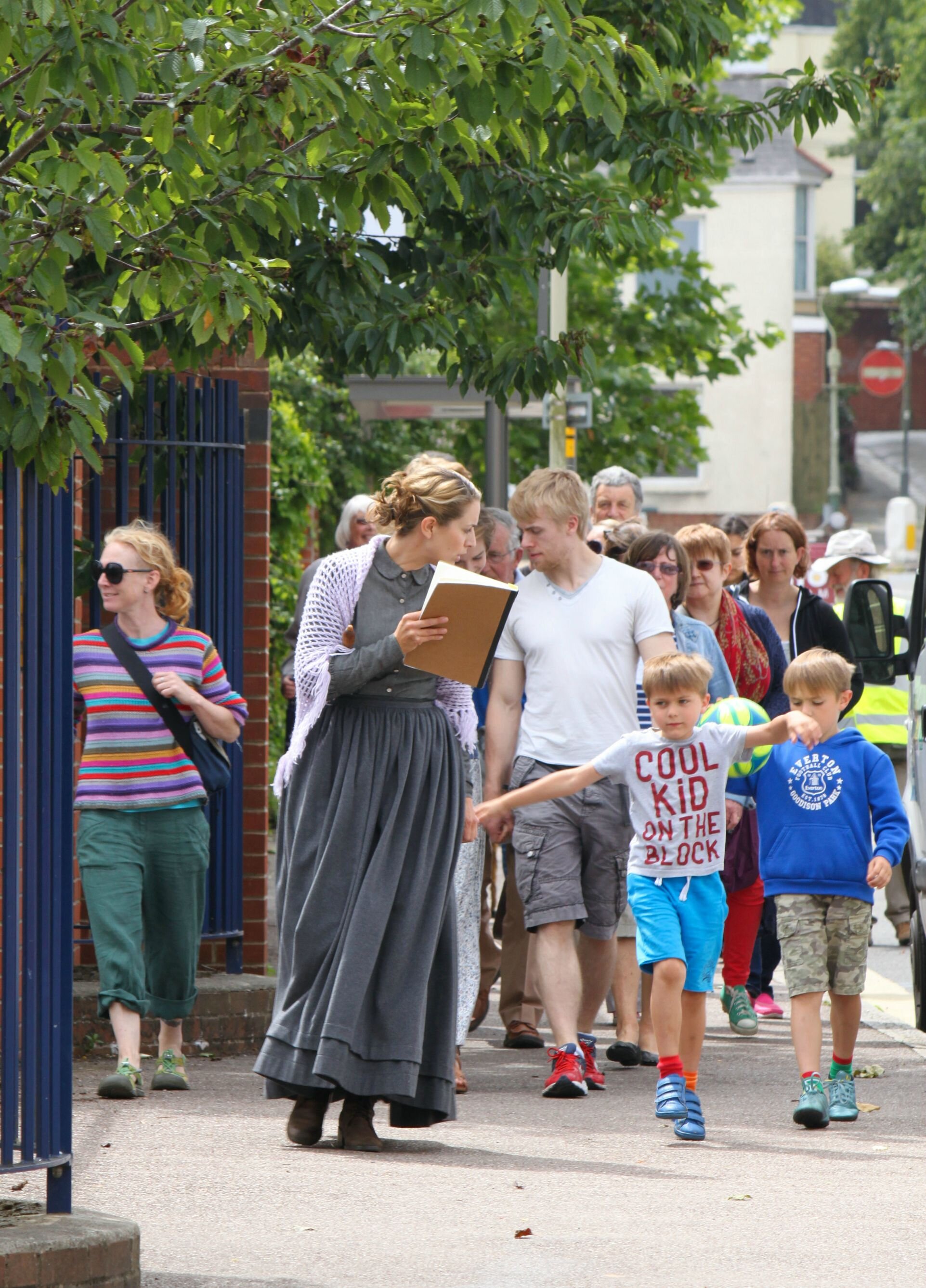Interwoven Productions CIC
Exeter-based Interwoven Productions CIC are specialists in Creative Placemaking via Circular Economy and are the authors of the ‘Squilometre’ technique for sustainable community animation. We spoke to Creative Director JoJo Spinks to get the full low-down…
What do you do?
Interwoven Productions CIC was originally established as a socially engaged performance company, but we’ve come to understand that we are Creative Placemakers. That understanding has been an evolution, and our practice has gradually shifted to the point of giving up our creative egos entirely to serve our communities in grassroots, community-commissioned, place-based, creative projects of all kinds. We’re based in Exeter and work on the street, alongside the communities of four city Wards in Exeter: Burnthouse Lane/Wonford, Heavitree, St Thomas and the West Quarter.
How did you start?
Interwoven started as a creative partnership between me, an ex-archaeologist turned writer/producer, and theatre director Alistair Ganley. Back in 2010/11, not long after the financial crash, there was an energy in Exeter from new, fledgling companies. There was much talk of creative ecosystems, which isn’t surprising because the city’s biggest theatre, the Northcott, had succumbed to the massive drain in creative funding and went into a spell of relative quiescence, despite a long history of having its own company and attracting national talent.
Gladly, that theatre is re-emerging now but, back then, it was exciting to see what was growing in the clearing once the sunlight started breaking through. Rather than one or two big organisations receiving support and serving the needs of the city, there were dozens of small, energised and inventive initiatives emerging. Supported by a culturally inclined local authority and fed by graduating University students, Exeter was an exciting place to be.
However, Interwoven was always a bit of a fir tree in a deciduous forest. We were never going to be a mighty oak; it just wasn’t in our DNA. Right from the start, we had to think differently, and find other ways around the big issues of funding and sustainability. Now, we’re very glad that we turned instead to Exeter’s neighbourhood communities to find a more participatory, collaborative approach. An approach that is standing us in very good stead during the current crisis.
In 2017, we became a Community Interest Company with a Board of four – myself, Alistair, Lindsey Hughes and Chris Spinks.
Who do you work with and why?
By early 2014, inspired by my experience as a landscape archaeology tutor, we decided to operate within, and serve, a specific geographic community within one square kilometre of landscape – a ‘Squilometre’. It’s an archaeological concept, to place a square metre grid down and to study in detail what is enclosed within. We just threw the net a little wider so that we were capturing the essence of ‘place’: its heritage, landscapes – green and built – and its people. More than that, our research for an answer to financial sustainability led us to develop a circularity within the square. We gave our first happening away to the residents of one street in Heavitree. Two hundred of them processed along that street with us, taking time to stop and view it anew, together. They stayed and chatted with us at the end, popped pay-it-forward donations into a hat while making nominations for which street, in their Squilometre, they’d like to celebrate next. Now, five years and nine street-based projects later, they continue to commission and participate in their own place-making creativity. With a little help from local authority small pot grants, the first Squilometre is a completely self-sustaining, community-led creative enterprise, going around and around their neighbourhood in community perpetual motion.
South Lawn Terrace: part of the Heavitree Squilometre project
With thanks to the National Lottery Heritage Fund and Devon County Council, there are now a further three Squilometres in Exeter, all operating in the same circular way: in Burnthouse Lane, St Thomas, and the West Quarter. Again, we didn’t know the terminology when we started but we became one of the first practitioners of a post-capitalist, circular economy operating as part of what some are calling a ‘Participation Revolution’.
Talk us through a favourite project.
The Wonford Village and Great House project has to be a favourite for many reasons. It’s one of those examples where learning to see modern landscapes differently can reveal such wonderful surprises. It turns out that beneath a modern block of flats, not far from Lidl, lie the remains of an early medieval manor house – with its very own moat! Dating from the time of King John (1199-1216), this important building would have been at the heart of a medieval demesne that stretched from Pyne’s Hill to the RD&E Wonford Hospital site, making it an incredibly important part of Exeter’s heritage. The project concentrated on re-connecting the modern Wonford population with the lost and hidden heritage of their place.
It was a joy to work alongside the residents who, over nine months, came up with a whole range of creative ways to reveal and celebrate that heritage. This included a moat recreation event with over 50 local school children. With the help of participatory visual artists who had run medieval imagery-inspired workshops with them, the children spent a busy, joyful morning spray painting on the ground exactly where the moat used to be. Their beautiful emblems also now feature on a community-commissioned and designed interpretation board and on trail-guides around the Village. The residents created merchandise for fund-raising, ran a reminiscence event and brought the whole thing together with a series of open-access street happenings, culminating in a lantern parade and party at the local community centre.
Active participants included the Heavitree and Wonford ECI Community Builders, local Devon County and Exeter City Councillors, Wynstream Primary School, the Wonford Methodist Church, the Wonford Community and Learning Centre, the Heavitree Local History Society, the Girl’s Brigade and the Beanies, but, most importantly, it was the residents who made it all happen.
What keeps you going when things get tough?
The realisation that culture already sits firmly within our communities. They don’t need to be taught what it is, they don’t need to be engaged with someone else’s vision of it or to have their stories re-framed, and they have every right to express it how they please. Now, when we start a street project, we never know how the creative expression will look. Our role is simply to facilitate and, if asked, hook communities up with an appropriate artist or expert to help fulfil their vision. And every once in a while they ask us to help them create a performance!
Name one thing that would make your life easier as an artist or arts organiser.
It’s already happening really and, surprisingly, it’s being aided by Covid-19. When we started talking about alternative economies and post-capitalism back in 2011, no one else seemed to be using that terminology, let alone getting on board with the concepts. Similarly, Creative Placemaking was an unknown. Now, our lives are much easier; the terms are at least out there and we’re being asked to speak and write about what they mean. Our financial and operational resilience in the current crisis is attracting particular attention.
What’s been the best moment for you or your group in the last year?
Undoubtedly receiving recognition and validation of the Squilometre approach from the National Lottery Heritage Fund. Receiving the award was great, of course, but far more important to us was that the funding was primarily to formalise our training to transfer the technique. Their support has allowed us to develop a 12-month flexible learning package for volunteer Place Champions, and that is what allows the technique to embed in a new neighbourhood. Now that we have that training written as a course, we can use it to start new Squilometres anywhere.
What does the next year look like for you?
This extraordinary time of lockdown has brought forward several of our more ambitious plans. We’re beginning discussion and funding plans now for an online portal where residents can upload the research and creative product of their place-based projects and connect with others doing the same elsewhere. It will also act as an environment where place champions and residents can learn from each other and from invited experts on themes of heritage interpretation and community animation. We didn’t expect to be moving in this direction quite so soon but it seems that we have all come to realise the importance of community and connection.
In what ways are you helping to put Exeter on the cultural map, nationally or internationally?
It is in the transferability of the technique that the real future lies. It is the perfect mechanism to act locally but think globally. From Aberdeen to Adelaide and Beijing to Beirut, there is no place that could not be celebrated in this way. Interwoven Productions CIC are active partners with the ArtWorks Alliance, the national network for ‘better participatory arts’, and are members of the international PlacemakingX movement. Working with them, we believe we can find the right way to make this happen.
What have you been doing during lockdown?
We’ve been busier than ever! Very early on we established online open forums where we chat daily. Our communications are open and two-way. We have always considered this to be an incredibly important part of our art. So, in this sense our service to our communities has been seamless and uninterrupted. More than this, though, we know that when we come back to pulling together resident steering groups and encouraging people to come join us on the street there’s going to be an even stronger appetite for what we do. In the meantime, plans that we already had, to develop free, online place-based resource packs have been brought forward and these have been distributed with an online reach of around 10,000. You can access this #ConnectMe series here.
What if…?
…city centre theatre and arts venues each had their own Squilometre? Then their conversations with their own animated communities would have continued all through this period, making it much easier for them to maintain service and, of course, to turn to those communities for direct support. A Duryard Squilometre for the Northcott that would include all the residents in the area plus the natural assets of the Duryard Valley Park to the north and Hoopern Valley to the south. A Rougemont Squilometre for the Phoenix and RAMM that acknowledged that there are residents there too, right in the heart of the city, and extending an invitation to each of them, plus an extraordinary richness of heritage to explore all within one square kilometre. A whole patchwork quilt of Squilometres, in fact, allowing each area of this city to celebrate and express itself on its own terms but then look up and find its connection with others.
How do we find out more?
Visit the website / like on Facebook / follow on Twitter
And you can vote to bring the Squilometre to your place, too: follow this link.


